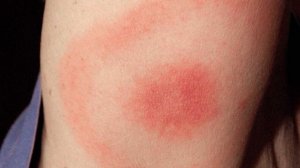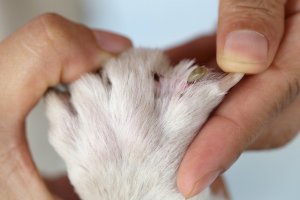There is no need to check out the latest scary flick at your local cinema. A real life horror story lurks hidden among us and threatens the quality of all our lives. It doesn’t lie in wait for hapless passersby, wielding a sharp knife. Instead, it hides undetected in the green grass and gardens adorning homes and fields.
Well known to our pest-control and pest-management specialists at Pestco Professional Services, its name is Lyme Disease, and to minimize the chance of you, your family or loved ones from getting it requires monthly tick control spraying programs to eliminate the presence of ticks from your Pittsburgh lawn — (412) 252-5200.
Lyme disease is one of the fastest-growing vector-borne infections in the United States, the number of cases increasing steadily over the past 25 years. According to the Center For Disease Control (CDC), more than 300,000 new cases appear annually.

Lyme Disease is a national health crisis that is largely ignored. It is the sixth most commonly reported infectious illness. Despite this, scientists believe that incidents are widely under-reported and misunderstood. Some estimates suggest that the number of Lyme disease cases is actually as much as 15 times higher than what is documented. To compound the problem, misdiagnosis is common and testing isn’t always accurate.
As many as 50% of those who test negative for the disease often have it. This is because there is no standard assessment within the medical field that truly indicates a positive condition. Available testing only focuses on markers for the disease’s early stages.
May is Lyme Disease Month, and no time could be more propitious for Pittsburgh homeowners to learn about the terror that lies on their lush, well-manicured lawns and inviting backyards.

Realtors often boast about the importance of a home’s location, location and location when selling properties, but where one calls home is also an issue that relates to the chances of contracting Lyme Disease. Those who live, spend time or have outdoor occupations in or near the grassy and heavily wooded areas of the Northeast and Midwest where ticks carrying Lyme disease thrive, are particularly susceptible.
What Exactly Is Lyme Disease?
Lyme disease is its own horror story. Like the vampire tale, Dracula, the villain is a blood sucking organism. Although unable to wear a long black cloak, its bite wreaks long-term, painful and sometimes lethal havoc with our hearts and other vital organs.
Unlike cinematic presentations, this malady has no happy ending where the hero saves the damsel from the clutches the wrathful vampire. Instead, if left untreated, this disease painfully and indelibly affects the quality of human life, rendering this narrative all the more horrible because it is preventable.
Within the United States, Lyme Disease is caused by the spiral shaped bacteria, Borrelia burgdorferi and Borrelia mayonii, which are carried by and transmitted to humans via the bite of an infected black-legged tick, commonly known as a deer tick.
In most cases, transmission usually occurs when the tick is attached for 36 to 48 hours. The bacteria gain ingress via the bite and eventually make their way into the human bloodstream. These insects are no larger than a poppy seed, which makes them not only difficult to spot but also unworthy of that expression about good things coming in small packages.
The History of Lyme Disease
Lyme Disease is not a modern malady. Research led by Katharine Walter at the Yale School of Public Health in a study that was published in Nature Ecology and Evolution, recently discovered that the Lyme disease bacterium dates back some 60,000 years where it existed in the forests of ancient North America. Evidence in the form of ticks trapped and fossilized in chunks of amber found in the Dominican Republic date back about 15 million years. A recent autopsy performed on a 5,300-year-old mummy indicated the presence of the bacterium that causes Lyme disease.

In 1883, a German physician named Alfred Buchwald, was the first to chronicle the skin rash, or target formation, associated with Lyme Disease. The malady itself was not recognized in the United States, however, until the 1960s and 1970s when a group of children and adults in the small town of Lyme, Connecticut, were collectively suffering from some mysterious, debilitating health issues which included: swollen knees, paralysis, skin rashes, headaches, and severe chronic fatigue.
Doctors were unable to diagnose and treat this unknown ailment, and had it not been for the perseverance of two caring mothers from this small Connecticut town who took notes, conducted their own research and hounded scientists for answers, the disease might be nameless to this day. By the mid 1970s, the disease had been identified and associated with a particular location, but the bacteria that caused it was not officially classified until 1981.
Relevant Studies and Statistics
According to a 2016 study conducted by Thomas Simmons, a biology professor at Indiana University of Pennsylvania, ticks infected with Lyme disease are just as prevalent in Pittsburgh’s city parks as they are in residential or recreational areas outside of the city. Their containment is a job best left to pest control and pest management professionals.
Data provided by the state health department affirms that Allegheny County is among the worst hit for Lyme Disease, ranking sixth among the state’s 67 counties for the most confirmed cases of Lyme disease (404).
According to Dr. Andrew Nowalk, assistant professor of pediatrics at Children’s Hospital of Pittsburgh of the University of Pittsburgh Medical Center (UPMC), more than 1,500 children each year are treated for Lyme. This disease greatly affects the young and middle-aged adults because they are the most likely to be outdoors. In Nowalk’s owe words: “It has definitely increased dramatically in the last three years. … In our hospital we’re seeing almost a twofold increase every year.”
Why is Lyme Disease in Pittsburgh On The Rise?
Dr. Alison Galdys, infectious diseases physician and assistant medical director of infection prevention at UPMC states: “While experts cannot pinpoint the number of cases, they agree that the rate of Lyme disease is increasing. It has spread certainly over the Northeast, and it’s spreading westward as well.” There are several factors that may account for the increased rate of infection.
According to Dr. Galdys, in the last few years, due to shrinking natural habitats for deer, there are more ticks in the area that carry the bacteria and spread the disease. There is also more awareness of Lyme among health providers who are testing more patients than previous years. Thirdly, the CDC has altered the definition of the disease, loosening requirements as to what is Lyme Disease and what isn’t.
What Are The Symptoms of Lyme Disease?
The human body’s response to the bacteria causes the symptoms that often arise. These include: fever, headache, fatigue, aches, relentless joint pain, brain fog, memory loss, facial palsy and a characteristic skin rash shaped like a target or bulls eye that may appear anywhere on the body.

Photo credit: Center For Disease Control
The signs and symptoms of Lyme disease vary and sometimes appear in stages. It can be elusive and difficult to diagnose, as not only do the stages of the disease often overlap, not everyone develops the hallmark target rash.
There is also confusion with the medical community concerning the diverse vectors of Lyme disease. Although deer ticks are the most commonly associated with transmission, lone star ticks, western black-legged ticks and wood ticks (or dog ticks) can spread the disease as well.
Another issue with proper diagnosis is the fact that more than 350 different diseases, including: fibromyalgia, Chronic Fatigue Syndrome, MS, ALS, Parkinson’s and Alzheimer’s share similar symptoms.
Testing for Lyme Disease Poses Serious Challenges
Most laboratories test for the presence of only one strain of bacteria (Borrelia burgdorferi) despite the fact that there are more than 300 strains of this bacterial species known throughout the world (100 in North America alone) which can cause Lyme Disease.
These other species of Borrelia are ignored mainly because the laboratories have difficulty isolating and identifying them, which retards proper study and understanding of the bacteria’s origin and development. These limitations account for the high probability of false negative test results.
Tick Prevention Tips For Pittsburgh Home Owners
Lyme disease has been reported in all states except for Hawaii. Pittsburgh homeowners must take precautions to protect themselves from this terrible malady.
Beth Rementer, spokeswoman for the Department of Environmental Protection, states: “Ticks aren’t just in the woods. They’re in parks, on playgrounds and on hikes. Taking the few extra steps while you’re enjoying the outdoors is very important as we head into peak tick season.”
The following are our collective suggestions to the public at large to help protect yourself:
Aim To Wear Light Colored Clothing
The American Lyme Disease Foundation recommends wearing light-colored clothing to make it easy to spot ticks.
Cover up In Wooded and Grassy Areas
Ticks attach easily to bare flesh. If you and your family are in an area where ticks are common, protect yourself and your children by wearing shoes, long sleeves and long pants tucked into socks. Don’t allow your pets to wander in tall weeds and grasses.
Be Sure You Use Insect Repellents
Only apply insect repellent to skin that has a 20 percent or higher concentration of DEET and that contains permethrin, which should be applied to clothing. Parents should apply repellant to their children, avoiding their hands, eyes and mouth. Follow directions carefully, as ingredients are often toxic.
Try To Tick-Proof The Back Yard
Homeowners should do their best to keep ticks out of their yards. This can be accomplished by clearing the brush and leaves where ticks live. Mowing the lawn on a regular basis is also a deterrent. Stacking wood neatly in dry, sunny areas discourages rodents that often carry ticks.
Check Clothing For Ticks On Yourself, Family Members And Pets
Deer ticks are no bigger than the head of a pin and are easily missed unless the search for them is careful and thorough. Take the time to do this, especially after being outside in woody or grassy areas.
Shower Soon After Coming Indoors
Showering immediately can prevent ticks form attaching to skin because they often remain for hours before actually affixing themselves. Showering and using a wash cloth can aid in removing them before they can do their damage.
Check Your Pets Regularly And Use A Tick & Flea Preventative
As ticks can also be brought into a home by dogs and cats, which can then become a human host, all dogs and cats which come in contact with the outdoors (due to deer, rabbits and other rodents, etc.) should see a veterinarian and be prescribed a monthly tick and flea preventative.

Pittsburgh Tick Control Services
Unfortunately, ticks are a big part of life in Pittsburgh and Western Pennsylvania, and the stay at home orders now in place throughout the state Pennsylvania only dramatize the need for immediate action in the form of maintaining lawns and spraying them frequently.
The abatement of of ticks encroaching upon your lawn requires monthly tick control programs from the team of professional pest-control and pest-management Quality Pro Certified technicians at Pestco Professional Services, who understand that no one product or service ever fits-all situations and/or solutions. We recommend engaging our monthly tick control program from April until November.

Our certified technicians are licensed and educated in the life cycle, biology, and control of local Tick species. They attend workshops regularly, which helps to keep them on top of the destructive and sometimes deadly insect pests they encounter every day on the job. They are generous with their knowledge, and always take the time to educate their clients on a course of action to prevent returning tick infestations. They welcome all questions and provide viable answers to all pest-related issues. Most importantly, our products are eco-friendly and promote a sustainable policy that will insure a green planet for future generations.

Over the course of the last seventy years, we have developed an unblemished reputation and to this day remain the leading pest-control and pest-management company in Pittsburgh and Western Pennsylvania, servicing such high-profile commercial accounts, including Heinz Field and PNC Park as well as homes and residences scattered all across the area.
In Conclusion
When life gives you lemons, we all know you should make lemonade, but when it threatens to give you Lyme Disease, its time to fight for your life and the lives of your family members.
Call our team today, (412) 252-5200, and let them help you free your property from this wretched and preventable disease. Act now. This summer the ticks are waiting for you. Make your welcome one that ensures they will never visit your property again!
Final thought on Lyme Disease: Having invisible, chronic illness is hard enough. Being doubted, judged, or dismissed is overwhelming and heartbreaking. ~Pinterest
What Exactly Is Lyme Disease?
Lyme Disease is caused by the spiral shaped bacteria, Borrelia burgdorferi and Borrelia mayonii, which are carried by and transmitted to humans via the bite of an infected black-legged tick, commonly known as a deer tick.
What Are The Symptoms of Lyme Disease?
The human body’s response to the bacteria causes the symptoms that often arise. These include: fever, headache, fatigue, aches, relentless joint pain, brain fog, memory loss, facial palsy and a characteristic skin rash shaped like a target or bulls eye that may appear anywhere on the body.
Why is Lyme Disease in Pittsburgh On The Rise?
According to Dr. Galdys, in the last few years, due to shrinking natural habitats for deer, there are more ticks in the area that carry the bacteria and spread the disease. There is also more awareness of Lyme among health providers who are testing more patients than previous years. Thirdly, the CDC has altered the definition of the disease, loosening requirements as to what is Lyme Disease and what isn’t.
What Steps Can I Take To Protect Against Tick Bites?
1) Wear light colored clothing
2) Cover up in wooded and grassy areas
3) Use insect repellents
4) Try to tick-proof the back yard
5) Check clothing for ticks on yourself, family members and pets
6) Shower upon coming indoors
 Over 300 Reviews
Over 300 Reviews 